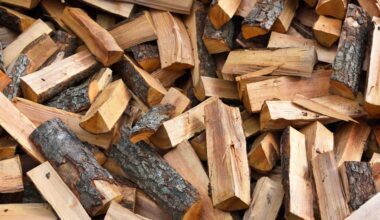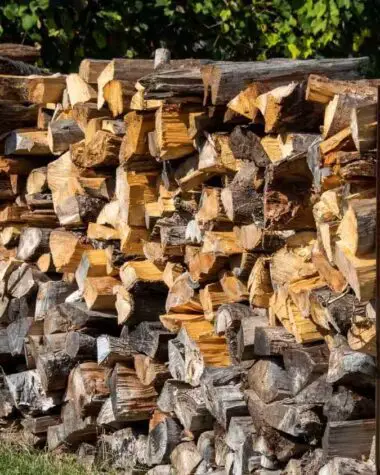There is no other known natural origin of wood aside from trees. They grow everywhere, and each of them is capable of providing wood. However, not all trees can be cut for wood. Only wood from certified forests can be cut because they are under the provision and care of various wood certification programs.
In addition, the numerous wood by-products in existence all originated from trees. Thus, no one would disagree that trees are not very important. They produce things useful for everyday living, plus they also protect the environment. This article will explore more of the benefits of trees and some essential information about woods.
The Structure of Wood
If you try to remove the outer “skin” or bark of wood from a tree, it will reveal its two essential parts. Closest to the edge of the outer bark is the layer called sapwood. This part is packed with tubes called xylem that deliver water from the roots to the leaves and the different structures of the tree.
Inside the sapwood, a much darker, harder part of the tree called the heartwood. Around the outer edge of the sapwood is a thin active layer called the cambium. This area is where the tree grows outward little by little each year.
Read | Sapwood vs Heartwood
The inner structure and composition of a tree make wood what it is and what it can be used for. There are hundreds of different tree species. Therefore, numerous wood types exist. Thus, making generalizations about “wood” isn’t always the best answer.
Industrial Wood Supply
In 1997, it was recorded that the world had consumed a total of 3.4 billion cubic meters of wood. More than half of this total amount was burned as fuel. With this huge figure of huge consumption, knowing that wood came from trees still needs more information. Where do manufacturers of wood get their supply of wood for industrial purposes?
Old-growth Virgin Forests
Many areas, including Russia and Canada, the Amazon Basin, and portions of other nations with tropical rainforests, still contain substantial tracts of old-growth forest. These large forest areas are the main source of wood used for industrial purposes.
Secondary-growth Forests
Natural forests that have been cut but have since regrown or been partially replanted, and are presently managed more or less actively for wood production, are known as “secondary-growth” forests.
Nearly all of the original forests in eastern North America (including the majority of the United States), Europe, and significant portions of South and East Asia have been replaced by secondary-growth forests.
Plantations
The degree of human involvement in the formation and management of a forest is typically used to describe plantations. The distinction between a semi-natural and a plantation forest is mainly arbitrary due to the variety of silvicultural approaches used in intense forest management. This idea is true, particularly in portions of China, the United States, and Europe.
As a result of their recent establishment or the presence of non-native plants that develop quickly, plantations are typically easier to spot in tropical and subtropical nations. Asia is home to almost half of the world’s plantations. Another 30% comes from the former Soviet Union and North and Central America.
The Journey of Wood
Wood must undergo a certain process that includes harvesting, drying, seasoning, and preserving before it can be cut and put together to create the wood products we use daily.
How wood is harvested depends on whether the trees are in your yard, a forest or a plantation. To regulate wood use, planted trees may be grown according to a plan and clear-cut or felled when the tree reaches maturity. This makes sense if the trees are fast-growing and planted specifically for use as biomass fuel.
Individual trees can also be selectively felled from a forest and hauled by trucks or airlifted by a helicopter to avoid damaging other trees. Sometimes trees have their bark and small branches cut while still in the forest before being hauled away for further processing in a nearby lumber yard, but some may be removed intact as the processing and cutting are done offsite.
Importance of Trees
In addition to being necessary for existence, trees serve as a bridge for humans to know the past, present, and future. Here are the reasons why.
Trees elevate the economy.
Living, working, and investing are all drawn to green environments. According to research, the average price of a home increases 5–18 percent when it is located near a mature tree. A healthier, happier staff benefits businesses if there are parks and trees nearby.
Trees protect nature.
As they expand, trees take in carbon dioxide, and the carbon they store in their wood slows the rate of global warming. As they lose moisture and reflect heat upward from their leaves, they lower wind speeds and chill the air. Also, with their ability to hold hundreds of liters of rainfall, trees also aid in reducing soil erosion and flooding.
Trees provide health benefits.
Tree canopies are a physical cover that captures dust and absorbs airborne toxins. They also lessen noise and offer cover from the sun.
According to research, being among trees and other greenery can lower stress levels, lower blood pressure, and reduce your heart rate.
Conclusion
Woods come from trees. However, the wood goes through processes in the forest or land where it is grown before it is used for any purposes. Wood is a useful product of nature used in the creation of various items we use every day. Thus, we must protect the trees which wood can be extracted from.








